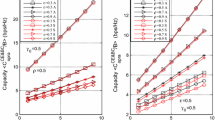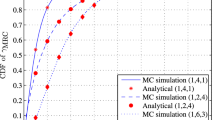Abstract
Novel closed-form expressions are derived for Ergodic channel capacity for fading channels with impairments due to combining errors for M-branch Rayleigh fading with Generalized Diversity Combining. Four different adaptation policies are analyzed for (1) maximal ratio combining (MRC) diversity, (2) spread spectrum (SS) diversity with MRC and Antenna diversity with selection combining (SC), and (3) SS diversity with SC and Antenna diversity with MRC diversity reception cases. Correlation is defined physically as the similarity between the channel coefficients of the pilot and the message. If the pilot and the message are highly correlated, we have a high system performance. Optimal power and rate adaptation policy yields the best spectrum efficiency, while channel inversion with fixed rate policy suffers the highest penalty in comparison to other policies.












Similar content being viewed by others
References
Zhou, X., Lamahewa, T. A., Sadeghi, P., & Durrani, S. (2008). Capacity of MIMO systems: Impact of spatial correlation with channel estimation errors. In 11th IEEE Singapore international conference on communication systems (ICCS), (pp. 817–822).
Jakes, W. C. (1994). Microwave mobile communications (2nd ed.). Piscataway, NJ: IEEE Press.
Gans, M. (1971). The effect of Gaussian error in maximal ratio combiner. IEEE Transactions on Communication Technology, 19(4), 492–500.
Saad, A., Ismail, M., & Misra, N., (2009). Rayleigh multiple input multiple output (MIMO) channels: Eigenmodes and capacity evaluation. In Proceedings of the international multiconference of engineers and computer scientists (IMECS), Hong Kong (vol. II).
Mareef, A., & Aissa, S. (2008). Impact of spatial fading correlation and keyhole on the capacity of MIMO systems with transmitter and receiver CSI. IEEE Transactions on Wireless Communications, 7(8), 3218–3229.
Trung, H., Benjapolakul, W., & Araki, K. (2008). Capacity analysis of MIMO Rayleigh channel with spatial fading correlation. IEICE Transactions on Fundamentals of Electronics, Communications and Computer Sciences, E91-A(10), 2818–2826.
Krone, S., & Fettveis, G. (2008). Capacity analysis for OFDM systems with transceievr I/Q imbalance. In IEEE global telecommunications conference, (GLOBECOM 2008), New Orleans, LA, (pp. 4572–4577).
Chen, J., Liou, C., & Tu, W. (2007). Applying the correlated Gamma statistics in channel capacity evaluation for dual-branch MRC diversity over correlated fading channels. In 11th WSEAS international conference on communications, Agios Nikolaos, Crete Island, Greece, (vol. 11, pp. 173–177).
Choi, S. H., Smith, P., Allen B., Malik, W. Q., & Shafi, M. (2007). Severely fading MIMO channels: Models and mutual information. In Proceedings of international conference on communications (ICC 2007), Glasgow, UK, (pp. 4628 –4633).
Bhaskar, V. (2008). Error probability for L-branch coherent BPSK equal gain combiners over generalized Rayleigh fading channels. International Journal of Wireless Information Networks, 15(1), 31–35.
Xie, W., Liu, S., Yoon, D., & Choung, J. W. (2006). Impacts of Gaussian error and doppler spread on the performance of MIMO systems with antenna selection. In International conference on wireless communications, networking and mobile computing (WiCOM), Wuhan, China (pp. 1–4).
Bhaskar, V. (2007). Spectrum efficiency eveluation for MRC diversity schemes under different adaptation policies over generalized Rayleigh fading channels. International Journal of Wireless Information Networks, 14(3), 191–203.
Win, M. Z., & Winters, J. H. (1999). Analysis of hybrid selection/maximal-ratio combining in Rayleigh fading. IEEE Transactions on Communications, 47(12), 1773–1776.
Win, M. Z., & Winters, J. H. (2001). Virtual branch analysis of symbol error probability for hybrid selection/maximal-ratio combining in Rayleigh fading. IEEE Transactions on Communications, 49(11), 1926–1934.
Calmon, F. P., & Yacoub, M. D. (2009). MRCS: Selecting maximal ratio combined signals—A practical hybrid diversity combining scheme. IEEE Transactions on Wireless Communications, 8(7), 3425–3429.
Kim, S. W., Ha, D. S., Kim, J. H., & Kim, J. H. (2001). Performance gain of smart antennas with hybrid combining at handsets for the 3GPP WCDMA system. In International symposium on wireless personal multimedia communications, Aalborg, Denmark (pp. 289–294).
Sahu, P. R., & Chaturvedi, A. K. (2005). Performance analysis of pre-detection EGC in exponentially correlated Nakagami-m fading channels. IEEE Transactions on Communications, 53(8), 1252–1256.
Alouini, M. S., & Simon, M. K. (1999). Performance of coherent receivers with hybrid SC/MRC over Nakagami- fading channels. IEEE Transactions on Vehicular Technology, 48(7), 1155–1164.
Annamalai, A., & Tellambura, C. (2002). Analysis of hybrid selection/maximal-ratio diversity combiners with Gaussian errors. IEEE Transactions on Wireless Communications, 1(3), 498–512.
Pushpavati, K., Mastan, S. K., Vijay Ram, V. N., & Sylvia, G. M. (2012). Performance analysis of hybrid combining schemes over Rayleigh fading channels in MIMO–OFDM systems. Google Journals, 83(1–8), 2012.
Ramesh, A., Chockalingam, A., & Milstein, L. B. (2003). Performance analysis of generalized selection combining of M-ary NCFSK signals in Rayleigh fading channels. In IEEE international conference on communications, Anchorage, Alaska (vol. 4, pp. 2773–2778).
Alouini, M., & Goldsmith, A. (1999). Capacity of Rayleigh fading channels under different adaptative transmission and diversity combining techniques. IEEE Transactions on Vehicular Technology, 48(4), 1165–1181.
Gradshteyn, I., & Ryzhik, I. (1994). Table of integrals, series, and products (5th ed.). San Diego, CA: Academic Press.
Wolfowitz, J. (1964). Coding theorems of information theory (2nd ed.). Berlin, NY: Springer.
Holma, H., & Toskala, A. (2002). WCDMA for UMTS (2nd ed.). New York: Wiley.
Simon, M. K., & Alouini, M.-S. (2005). Digital communication over fading channels (2nd ed.). Wiley: New York.
Author information
Authors and Affiliations
Corresponding author
Rights and permissions
About this article
Cite this article
Subhashini, J., Bhaskar, V. Ergodic Channel Capacity for Rayleigh Fading Channels with Impairments Due to Errors in M-Branch Hybrid Diversity Combining. Wireless Pers Commun 94, 1035–1056 (2017). https://doi.org/10.1007/s11277-016-3668-z
Published:
Issue Date:
DOI: https://doi.org/10.1007/s11277-016-3668-z




